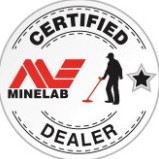
For more user reviews of metal detectors visit the new Metal Detector Database. Do not miss Steve's Guide to Gold Nugget Detectors for honest opinions on gold nugget detectors updated on a regular basis. Visit the Detector Prospector Forums for expert advice. User Guides & Catalogs here.
Fisher CZ Models - Some old favorites. Fisher CZX - Speculative new detector model.... Fisher F19 - General purpose VLF detector with prospecting mode. Fisher F75 - Flagship VLF model with prospecting mode. Fisher Gold Bug 2 - Dedicated VLF prospecting detector, extremely hot on small gold. Fisher Gold Bug Pro - Excellent value general purpose VLF prospecting detector. Fisher Manta - New pulse induction beach detector in the works at First Texas. Garrett AT Gold - Excellent value waterproof VLF prospecting detector. Garrett ATX - High performance pulse induction beach and prospecting detector. Garrett Infinium LS - Pulse induction beach and prospecting detector. Minelab Equinox 800 - General purpose detector with prospecting mode. Minelab Eureka Gold - Dedicated VLF prospecting detector, three selectable frequencies. Minelab Gold Monster 1000 - Dedicated VLF prospecting detector, extremely hot on small gold. Minelab GP 3000 - High performance pulse induction prospecting detector. Minelab GPX 4500 - High performance pulse induction prospecting detector. Minelab GPX 5000 - High performance pulse induction prospecting detector. Minelab GPZ 7000 - New high performance professional prospecting detector. Minelab SDC 2300 - Pulse induction prospecting detector, extremely hot on small gold. Minelab X-Terra 705 Gold - General purpose detector with prospecting mode. Nokta/Makro AU Gold Finder - Dedicated VLF prospecting detector, extremely hot on small gold. Nokta/Makro FORS Gold - General purpose VLF detector with prospecting mode. Nokta/Makro FORS Gold Plus - Excellent value VLF prospecting detector. Nokta/Makro Gold Kruzer - General purpose waterproof gold prospecting detector. Nokta/Makro Gold Racer - General purpose gold prospecting detector. Nokta/Makro Impact - Flagship VLF detector with prospecting mode. Nokta/Makro Racer - General purpose detector with prospecting mode. Teknetics T2 - Flagship VLF detector with prospecting mode. Tesoro Lobo SuperTRAQ - General purpose VLF prospecting detector. White's GMT - Dedicated VLF prospecting detector, very hot on small gold. White's GMZ - Dedicated VLF prospecting detector, hot on small gold. White's Goldmaster 24K - Dedicated VLF prospecting detector, extremely hot on small gold. White's MXT - General purpose VLF detector with prospecting mode. White's MX Sport - General purpose waterproof VLF detector with prospecting mode. White's TDI - Pulse induction beach and prospecting detector. White's V3i - Flagship VLF model with prospecting mode. XP DEUS V5 - Flagship VLF model with prospecting mode. XP ORX - New model from XP with an emphasis on gold prospecting. Comparison Reviews
Garrett ATX vs Minelab GPX 5000 Waterproof Pulse Induction Detectors Compared For more user reviews of metal detectors visit the new Metal Detector Database.
- Read more...
- 31,336 views









